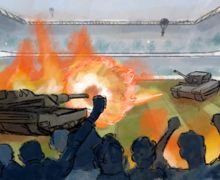Splice : In the zone
‘Green Zone’
Director: Paul Greengrass
Starring: Matt Damon, Greg Kinnear, Khalid Abdalla, Yigal Naor, Amy Ryan
Rating: 4 of 5 popcorns
No filmmaker takes more pleasure in disorienting and distressing his audience than Paul Greengrass, whose latest picture, ‘Green Zone,’ is expectedly crazy.
The director of perhaps the most unforgettable film of the last decade, ‘United 93’ (2006), and arguably the best action film of the last decade, ‘The Bourne Ultimatum’ (2007), Greengrass is well known for his trademark shaky-cam aesthetic, one of the most recognizable techniques in cinema. He is a beacon of hope in an era when action movies encourage audiences to melt into their seats with computer-generated imagery explosions supplanting old-school thrills.
The action in ‘Green Zone’ is set in March 2003, during the days leading up to the Iraq War. In desperate search of weapons of mass destruction, the United States is relying on Chief Warrant Officer Roy Miller (Matt Damon) and his platoon to unearth some proof that will bolster the United States’ case in declaring war. Like Jason Bourne, the inquisitive Miller is crafty, commanding and brutish when he needs a quick answer to meet a deadline. Like Jason Bourne, he’s explosively efficient.
When the stalwart Miller continually comes up empty after being fed falsified leads, he becomes suspicious and suspects that government officials, namely the blatantly villainous Clark Poundstone (Greg Kinnear), might have led him astray on purpose. With the assistance of a disabled but keen and highly motivated rebel named Freddy (Khalid Abdalla), Miller manages to expose a few secrets and inch closer to the elusive General Al Rawi (Yigal Naor). An equally conspiracy-weary Wall Street Journal reporter, Lawrie Dayne (Amy Ryan), informs Miller of a source named Magellan, whose actions and advice might have prompted, and subsequently complicated, the entire ordeal.
The best action film director in the cinema today, Greengrass stands alongside Michael Mann as a master of turbulent filmmaking. The preciseness with which Greengrass composes his disorienting action sequences is astonishing. He establishes a rhythm that the film pulses to in riveting fashion. Similar to Michael Mann, whose film ‘Collateral’ (2004) validated the use of a less stable camera in expensive studio features, Greengrass revels in rejecting convention in order to achieve a heightened sense of reality. Where 3-D films such as ‘Avatar’ (2009) distance themselves from the audience by constantly reminding viewers that they are watching a movie, Greengrass’ cinema is participatory, and ultimately more engaging and physically draining.
Released seven years after the outbreak of the war, ‘Green Zone’ benefits from hindsight, toying cleverly with varying ideals concerning U.S. intervention in Iraq. In adapting Rajiv Chandrasekaran’s ‘Imperial Life in the Emerald City’ for the screen, master screenwriter Brian Helgeland (‘Mystic River’) focuses the dramatic energy on singular insights pertaining to the fate of Iraq rather than boring audiences with a typically broad overview of the United States’ intentions. The motives of a solider (Miller), journalist (Dayne), warmonger (Poundstone), concerned citizen (Freddy) and high-ranking Iraqi official (Al-Rawi) complement each other perfectly, highlighting the concerns that made the impending conflict so controversial.
While Greengrass succeeds in depicting complex moral dilemmas, he remains a mediocre dramatist. ‘Green Zone’ is dense by the paltry standards set by comparably expensive action movies, but it lacks emotional resonance and says little about the human condition. With only five films to his credit, though, Greengrass still has time to evolve into an artist whose ability to portray subtle human emotions does justice to his aesthetic.
Unlike every one of Greengrass’ prior works, which ennobled Iraq War cinema, ‘Green Zone’ is neither devastating nor revolutionary. It is merely startlingly powerful cinema with the potential to shake any viewer to his or her core.
Published on March 24, 2010 at 12:00 pm





